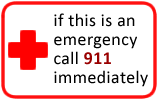Eye - Red Without Pus
Eye - Red Without Pus
Does this describe your child's symptoms? |
Definition
Causes
Return to School
|
If not, see these topics
|
When to Call Your Doctor |
Call Your Doctor Now (night or day) If |
|
|
|
Call Your Doctor Within 24 Hours (between 9 am and 4 pm) If |
|
|
|
Call Your Doctor During Weekday Office Hours If |
|
|
|
Parent Care at Home If |
|
|
HOME CARE ADVICE FOR RED EYE WITHOUT PUS |
Treatment For Viral Eye Infections
Reassurance:
Some viruses cause watery eyes (viral conjunctivitis).
It may be the first symptom of a cold.
It isn't serious and you can treat that at home.
Colds can also cause a small amount of mucus to collect in the inner corner of the eye.
Eye Cleansing: Cleanse eyelids with warm water and a clean cotton ball at least every 2 hours while your child is awake and at home. This usually will keep a bacterial infection from occurring.
Artificial Tears:
Artificial tears often make red eyes feel better. (no prescription needed)
Use 1 drop per eye 3 times a day. Use them after cleansing the eyelids.
Antibiotic and vasoconstrictor eyedrops do not help viral eye infections.
Contacts: Children with contact lenses need to switch to glasses temporarily (reason: to prevent damage to the cornea).
Contagiousness:
Pink eye with a watery discharge is harmless and mildly contagious.
Children with colds in the eye do not need to miss any child care or school.
Pinkeye is not a public health risk and keeping these children home is over-reacting. If asked, tell the school your child is on eyedrops (artificial tears).
Expected Course: Pink eye with a cold usually lasts about 7 days.
Call Your Doctor If:
Yellow or green discharge develops
Redness lasts for more than 1 week
Your child becomes worse
Treatment For Mild Eye Irritants
Reassurance: Most eye irritants cause transient redness of the eyes. You can treat that at home.
Face Cleansing: Wash the face with mild soap and water. Wash off eyelids with water. This will remove any irritants.
Eye Irrigation: Irrigate the eye with warm water for 5 minutes.
Eye Drops:
Red eyes from irritants usually feel much better after the irritant has been washed out.
If they remain uncomfortable and bloodshot, instill artificial tears or a long-acting vasoconstrictor eye drops (no prescription needed).
You can ask your pharmacist to recommend a brand.
Use 1 drop every 8 to 12 hours as necessary.
Expected Course: After removal of the irritant, the eyes usually return to normal color in 1 to 2 hours.
Prevention: Try to avoid future exposure to the irritant.
Call Your Doctor If:
Develops yellow or green pus in the eye
Redness lasts over 7 days
Your child becomes worse
And remember, contact your doctor if your child develops any of the "Call Your Doctor" symptoms.
Updated:
March 22, 2017



